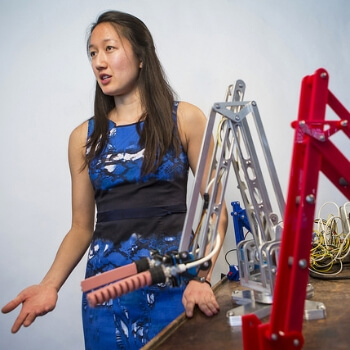News
Jenny Chang, S.B. '16 (mechanical engineering), discusses her senior thesis project, which is a scalable deep sea robotic arm. (Photo by Eliza Grinnell/SEAS Communications.)
Whether plumbing the depths of the ocean floor or blasting off into outer space, students set their sights on solving complex problems in “Engineering Design Projects” (ES 100). The capstone course at the Harvard John A. Paulson School of Engineering and Applied Sciences (SEAS) challenges seniors to develop a creative project that solves a real-world engineering problem.
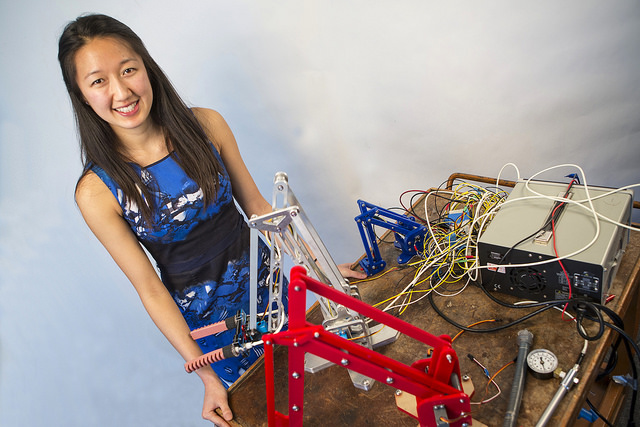
Sea Research: A Scalable Deep Sea Robotic Arm
Jenny Chang, S.B. ’16, mechanical engineering
Advisor: Rob Wood, Charles River Professor of Engineering and Applied Sciences
Deep sea coral reefs teem with life, but gathering samples from such a delicate environment is challenging. Chang developed a robotic manipulator system with four degrees of freedom that enables researchers to safely take reef samples using soft robotic grippers. Her intuitively-controlled robotic arm is small enough to be used with the remotely operated underwater vehicles typically utilized by academic research teams, but nimble enough to be effective in reef environments of different shapes and sizes.
“This project taught me so much about the entire process of building something on my own,” she said. “I learned that it is important to rigorously analyze the design. In the case of my project, I had to ensure that it could carry the loads that I wanted it to and operate within the deep sea environment.”
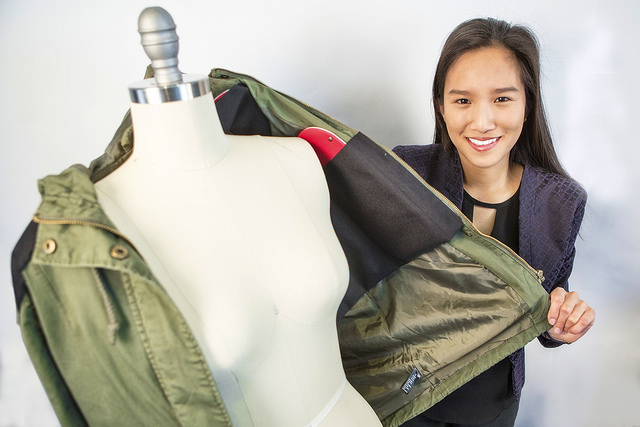
Tego: Impact Jacket for Commuter Cyclists
Stephanie Manivanh, S.B. ’16, mechanical engineering
Advisors: Katia Bertoldi, John L. Loeb Associate Professor of Natural Sciences and Zhigang Suo, Allen E. and Marilyn M. Puckett Professor of Mechanics and Materials
Bicyclists on the streets of Boston dodge cars, pedestrians, and stationary obstacles as they wind through congested traffic – and sometimes they crash. Manivanh developed a jacket that incorporates three different safety features to dissipate or reduce the force of an impact: a hard shell, an interior cushion, and abrasion-resistant fabric that helps a fallen cyclist slide on the ground. The jacket’s armor is arranged to minimize the impact on four areas of the body with the highest rate of injury: the clavicles, elbows, ribs, and spine. The trick, Manivanh said, will be to convince cyclists they need protection, since only 63 percent wear helmets.
“The biggest engineering lesson I learned from this project is to double and triple check the results of all my experiments,” she said. “Performing such a large amount of data analysis made me realize just how much data, and backup data, goes into manufactured products.”
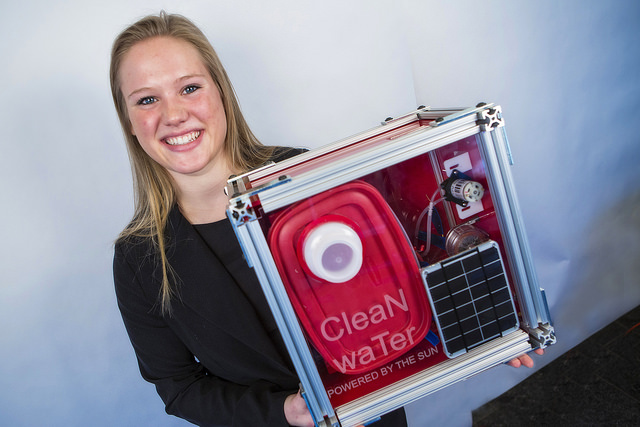
CleaN WaTer: A Water Filtration System Powered by the Sun and Carbon Nanotube (CNT) Technology
Emily Bonfig, S.B. ’16, mechanical engineering
Advisor: Chad Vecitis, Associate Professor of Environmental Engineering
In Manchay, an impoverished shantytown on the slopes above Lima, Peru, reliable access to clean water is out of reach for many families. Bonfig, who visited the slum during a collaborative, project-oriented field program offered by SEAS, developed an affordable, efficient water filter that uses carbon nanotubes to remove microbial contaminants from drinking water. The filtration system utilizes a solar panel to charge a battery that operates the water pump and electrochemical filter, which effectively removed 100 percent of e. coli bacteria from lab water samples. The low-power filter can produce five liters of clean, drinking water with each charge.
“My favorite part of ES-100 was the community feel of the seniors working together,” she said. “Even though we were all working on different projects, it felt like we were working toward a common goal. It was great to have support from so many of my peers.”
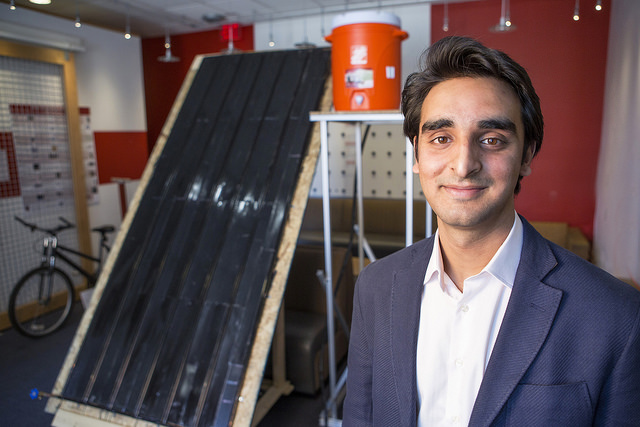
The Solar Siphon
Mir Ibrahim, S.B. ’16, mechanical engineering
Advisor: David Clarke, Extended Tarr Family Professor of Materials
Deforestation is a growing problem in rural Pakistan where villagers who lack access to electricity cut firewood to heat water. Ibrahim, a Pakistan native, developed a passive solar water heater to provide villagers with a low-cost, environmentally friendly solution. In Ibrahim’s prototype, aluminum fins, which are wrapped around a series of copper pipes, absorb sunlight to heat water moving through the pipes. The heater uses gravity and the principles of heat convection to move the water into a tank, without the need for mechanical pumps. This enabled Ibrahim to keep the cost significantly lower than the retail price of most passive solar water heaters. Since many Pakistani women spend much of their time gathering firewood, Ibrahim’s affordable solar water heater could free up their time for other activities, such as contributing to the household income.
“Through this project, I learned a lot about perseverance,” he said. “There were a lot of times where my prototype failed and I wasn’t sure if I would be able to build the device. But if you put your mind to something, and you’re willing to keep trying, you can eventually get it done.”
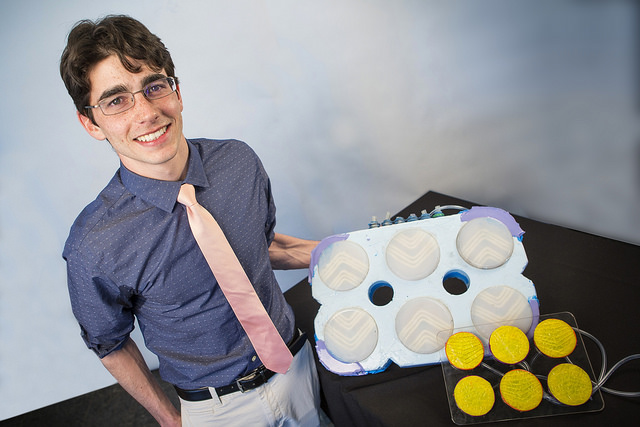
The Magic Carpet: A Novel Soft Robot
Andy O’Rourke, S.B. ’16, biomedical engineering
Advisors: Robert Howe, Abbott and James Lawrence Professor of Engineering, and Peter Hammer, Staff Scientist at Boston Children’s Hospital
After taking a hard look at soft robots, O’Rourke realized that most designs lack the strength and power needed to carry heavy loads. To tackle that shortfall, he designed a scalable soft robotic platform that is propelled by a set of six membranes, each with an embedded pattern of nylon rope. As air flows in and out of the membrane actuators, the nylon cords grip the ground, moving the robot forward. The system maximizes horizontal movement while minimizing vertical movement, which enables the robot to move faster than other designs. This unique motion provides the soft robot with enough power and stability to move forward while carrying a load of 55 kilograms, five times its weight. O’Rourke also developed a theoretical model for speed, so researchers could evaluate future soft robotic platforms before building prototypes.
“Current motion techniques work when a soft robot is connected to a wall supply, but even when you have to carry just five kilograms of machines on board, it just doesn’t move anywhere,” said O’Rourke. “If the technology I developed could enable enough weight-bearing to even get a battery onto the robot, that would be huge.”
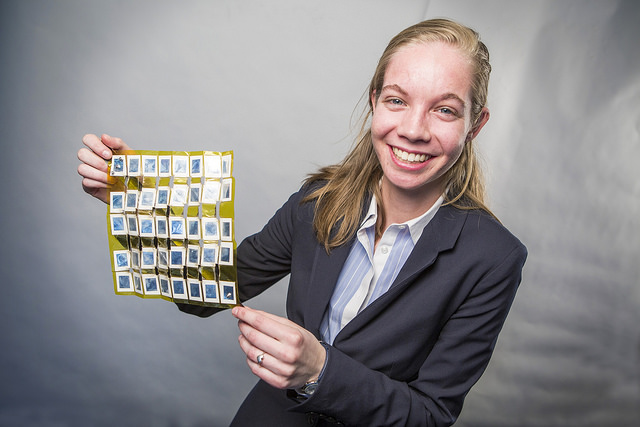
Alternative Mechanical System for Satellite Solar Arrays
Juliette Mahaffey, S.B. ’16, mechanical engineering
Advisor: Rob Wood, Charles River Professor of Engineering and Applied Sciences
Tiny cube satellites sent up into the Earth’s orbit often carry a heavy price tag; it can cost more than $19,000 for a hinged solar array to power the miniature data-gathering devices. Mahaffey used an origami design, the Miura Fold, to develop a model of an affordable, lightweight solar array that could generate the 30 watts of power needed for the miniature satellites. Her pop-up solar array weights only 29 grams and deploys in less than half a second. The biggest benefit of the device, she said, is that it is made using components and techniques that a university research team could replicate in-house, without having to purchase a costly, pre-made system.
“It was very challenging to model how it would actually work in space because, obviously, the gravitational environment is very different,” she said. “Using the origami fold makes the device easier to reproduce by researchers who are using these smaller satellites. It is also more lightweight than other solar arrays, and reducing the weight of a payload is generally desirable for launches.”
Students in ES 100 utilized the Active Learning Labs at SEAS to design and build their senior project prototypes. The unique lab spaces provide students with hands-on experience using state-of-the-art technologies.
Follow @harvardseas on Instagram to see more photos of students and their ES 100 projects.
Engineering Sciences 100 Course Overview
Woodward (Woody) Yang, Gordon McKay Professor of Electrical Engineering and Computer Science, describes the undergraduate capstone class, "Engineering Design Projects" (ES 100).
Cutting-edge science delivered direct to your inbox.
Join the Harvard SEAS mailing list.
Press Contact
Adam Zewe | 617-496-5878 | azewe@seas.harvard.edu
